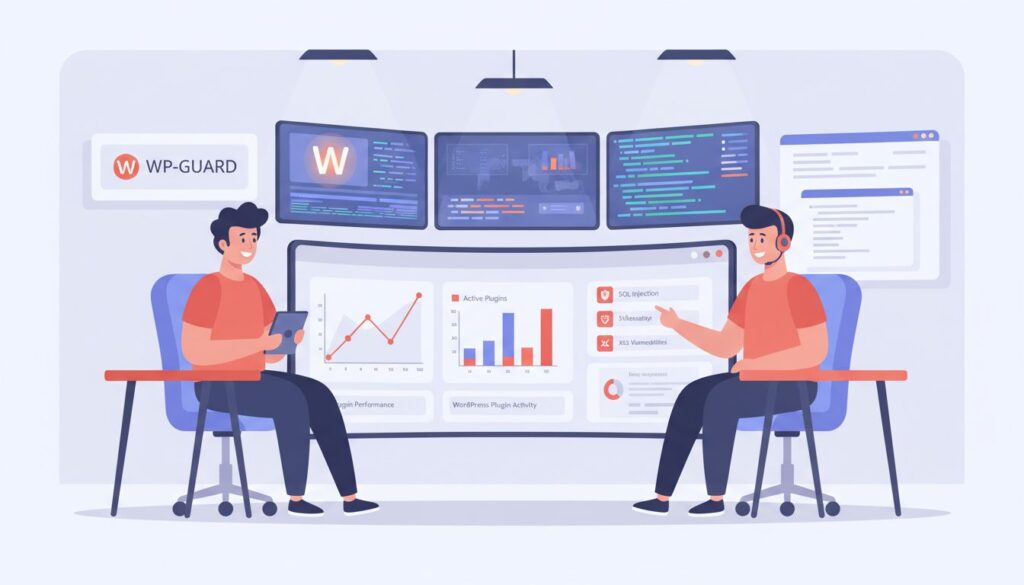Most WordPress sites rely on dozens of plugins and themes, yet over 60 percent of security breaches stem from outdated or poorly configured components. Understanding what drives a website below the surface helps web professionals spot vulnerabilities, unlock performance gains, and make smarter decisions. Whether you want stronger security, faster user experiences, or insider knowledge on competitors, a thorough WordPress site analysis reveals opportunities you might never notice otherwise.
Key Takeaways
| Point | Details |
|---|---|
| Comprehensive Site Analysis | Systematic examination of WordPress sites reveals vital insights into configuration, performance, and security vulnerabilities. |
| Importance of Plugin and Theme Detection | Understanding active plugins and themes provides critical data for security assessments and performance optimization. |
| Proactive Security Strategies | Deep analysis facilitates vulnerability detection and threat mapping, transforming security approaches from reactive to strategic. |
| Competitive Intelligence | Analyzing competitors’ technological choices aids in market positioning and lead generation, enhancing strategic outreach efforts. |
What “Analyzing WordPress Sites” Means
WordPress site analysis is a systematic process of examining and understanding the technical, structural, and performance characteristics of a WordPress website. Site analysis involves deep investigation of multiple digital components that reveal critical insights about a site’s configuration, functionality, and potential vulnerabilities.
At its core, analyzing a WordPress site includes examining several key technical dimensions:
- Plugin Detection: Identifying every active plugin and understanding its version, functionality, and potential security implications
- Theme Investigation: Evaluating the WordPress theme’s structure, customization levels, and potential performance bottlenecks
- Technical Configuration: Assessing server settings, PHP versions, WordPress core version, and overall site infrastructure
- Performance Metrics: Measuring site speed, loading times, and potential optimization opportunities
Professionals conduct WordPress site analysis for diverse strategic purposes. Explore our guide on analyzing WordPress sites to understand the comprehensive approach. Digital marketers might use site analysis to research competitor technologies, while security experts leverage these insights to identify potential vulnerability entry points.
The analysis process goes beyond surface-level examination. It requires specialized tools and techniques to extract granular details about a site’s digital ecosystem. Professionals use browser extensions, web crawlers, and advanced scanning technologies to decode the intricate layers of a WordPress installation, revealing everything from active plugins to hidden configuration details.
Why Plugin And Theme Detection Matters
Plugin and theme detection represents a critical investigative process for understanding the technological infrastructure of WordPress websites. By revealing the specific tools and design frameworks powering a site, professionals gain unprecedented insights into digital strategy, performance potential, and potential security landscapes.
WordPress ecosystem complexity means that each plugin and theme carries unique characteristics that dramatically impact site functionality. Learn how to analyze plugins for effective site insights to understand the intricate relationship between technological components and site performance.
As noted by WordPress, theme detection tools help users identify critical site design elements, providing valuable details such as theme name, version, and description. These insights unlock multiple strategic advantages for digital professionals:
- Competitive Research: Understanding competitors’ technological choices
- Security Assessment: Identifying potentially vulnerable plugin versions
- Performance Optimization: Recognizing resource-intensive themes and plugins
- Design Inspiration: Discovering innovative design and functionality approaches
Beyond surface-level examination, plugin and theme detection offers a comprehensive window into a website’s digital DNA. Professionals can map technological dependencies, evaluate design strategies, and make informed decisions about potential improvements or migration strategies. This granular understanding transforms website analysis from a passive observation into an actionable intelligence gathering process.
How Analysis Powers Security Insight
Website security is no longer a passive defense mechanism but an active, intelligence-driven process. Comprehensive WordPress site analysis transforms traditional security approaches by providing deep, granular insights into potential vulnerabilities and threat landscapes.
Research from the SCANTRAP study reveals critical insights into how automated scanning techniques can expose website vulnerabilities. The study demonstrates that systematic analysis can uncover potential entry points that automated attackers might exploit, enabling proactive security strategies.
Professionals leverage multiple dimensions of site analysis to enhance security:
- Vulnerability Detection: Identifying outdated plugins and themes with known security risks
- Code Quality Assessment: Analyzing potential weaknesses in site architecture
- Threat Mapping: Understanding potential attack vectors and system dependencies
- Continuous Monitoring: Tracking changes that might introduce new security risks
WordPress security plugins further empower this approach by providing automated code quality checks and vulnerability assessments. These tools examine themes and plugins against established security standards, helping developers and site administrators preemptively address potential security gaps before they can be exploited.
Ultimately, site analysis transforms security from a reactive process to a strategic, intelligence-driven approach.
By understanding the intricate technological ecosystem of a WordPress site, professionals can develop robust, adaptive security strategies that anticipate and neutralize potential threats before they manifest.
SEO And Performance Analysis Benefits
WordPress site analysis transforms digital strategy by providing deep insights into performance and search engine optimization potential. By dissecting the intricate technological components of a website, professionals can unlock powerful opportunities for improvement and competitive positioning.
Explore the latest WordPress SEO strategies to understand how comprehensive site analysis drives measurable digital performance. Performance and SEO analysis offers multifaceted benefits that extend far beyond surface-level metrics:
- Technical SEO Optimization: Identifying and resolving underlying site structure issues
- Page Speed Enhancement: Detecting performance bottlenecks from plugins and themes
- Competitive Benchmarking: Understanding technological approaches of top-performing sites
- Resource Efficiency: Eliminating unnecessary technological overhead
Website analysis provides a granular view of digital infrastructure, revealing how each technological component contributes to overall site performance. Developers and marketers can pinpoint exact elements causing slowdowns, SEO limitations, or user experience challenges, transforming abstract metrics into actionable improvement strategies.
Ultimately, comprehensive WordPress site analysis empowers professionals to make data-driven decisions.
By understanding the intricate relationships between plugins, themes, and site performance, teams can develop targeted optimization strategies that dramatically improve search engine rankings, user engagement, and overall digital effectiveness.
Competitive And Lead Generation Intelligence
Competitive intelligence in the digital ecosystem goes far beyond simple website observation. WordPress site analysis transforms raw technological data into strategic insights that power sophisticated marketing and lead generation approaches.
Explore the role of WordPress in modern marketing strategies to understand how technological forensics can unlock unprecedented competitive advantages. Site analysis provides a multi-dimensional view of digital strategies that traditional market research cannot match:
- Technology Stack Mapping: Identifying competitors’ technological investments
- Lead Qualification: Discovering potential clients through plugin and theme usage
- Market Trend Detection: Understanding emerging technological preferences
- Strategic Positioning: Benchmarking against industry technological standards
Professionals can leverage site analysis to build sophisticated intelligence profiles. By examining the intricate details of WordPress installations—from active plugins to theme configurations—marketers and business developers can construct nuanced understanding of potential clients, competitors, and market dynamics.
Here’s a comparison of key benefits provided by WordPress site analysis in different strategic areas:
| Area | Primary Benefit | Example Insight |
|---|---|---|
| Security | Vulnerability detection | Outdated plugin risks |
| Performance & SEO | Site speed optimization | Slow-loading plugin identification |
| Competitive Research | Technology stack discovery | Competitors’ theme usage |
| Lead Generation | Qualified outreach targeting | Plugin preferences of prospects |
| Compliance | Regulatory risk reduction | GDPR-related plugin assessments |
The true power of competitive intelligence lies in transforming passive data into actionable strategies. WordPress site analysis enables teams to move beyond surface-level observations, creating targeted outreach approaches, identifying potential partnership opportunities, and developing precision-driven marketing campaigns that speak directly to technological preferences and business needs.
Common Oversights When Skipping Analysis
Neglecting WordPress site analysis creates hidden vulnerabilities that can devastate digital infrastructure. What seems like a minor shortcut can expose businesses to significant technological and strategic risks that compound over time.
Research from the SCANTRAP study reveals critical insights into the dangers of bypassing comprehensive site analysis. The research demonstrates how automated scanners can exploit unexamined WordPress installations, revealing that seemingly innocuous technological gaps can become serious security entry points.
Common oversights when skipping site analysis include:
- Security Blindspots: Undetected plugin vulnerabilities
- Performance Degradation: Unoptimized site configurations
- Compliance Risks: Overlooked regulatory technology requirements
- Competitive Disadvantages: Missed optimization opportunities
WordPress security plugins underscore the importance of thorough theme and plugin examination. Professional analysis transforms potential weaknesses into strategic strengths, providing a comprehensive view of digital infrastructure that goes far beyond surface-level assessments.
Ultimately, skipping WordPress site analysis is like navigating a complex landscape without a map. Professionals who invest time in deep technological understanding can anticipate challenges, optimize performance, and create resilient digital ecosystems that adapt and thrive in an increasingly complex online environment.
Unlock Deeper Insights Into Your WordPress Site’s True Potential
Struggling to identify hidden vulnerabilities or optimize your WordPress site for peak performance and SEO? The complexity of plugin and theme detection presents real challenges when you want to secure, improve, or outsmart the competition. You need more than surface checks. You need detailed, real-time data on every active component powering your site.
With WPoptic you gain access to trusted technology that uncovers critical plugin and theme insights, letting you discover security gaps, performance bottlenecks, and competitive opportunities instantly. Our platform supports developers, marketers, and security professionals with powerful tools for lead list creation based on plugin usage and competitor analysis via easy browser extensions.
Take control now and turn hidden WordPress data into your biggest advantage. Start exploring how WPoptic can transform your site analysis tasks today by visiting our lead list tool. Discover actionable intelligence that strengthens security, enhances SEO, and fuels smarter outreach. Don’t let unidentified plugins or outdated themes hold you back. Act now to gain the clarity your WordPress ecosystem deserves.
Frequently Asked Questions
What does analyzing a WordPress site involve?
Analyzing a WordPress site involves examining its technical, structural, and performance characteristics, including plugin and theme detection, technical configuration assessment, and performance metrics evaluation.
Why is plugin and theme detection important when analyzing a WordPress site?
Plugin and theme detection helps identify the specific tools and frameworks used on the site, providing insights into performance, security risks, and competitive strategies that can inform future optimizations.
How can site analysis improve WordPress security?
WordPress site analysis enhances security by identifying outdated plugins, assessing code quality, mapping potential threats, and enabling continuous monitoring to address vulnerabilities proactively.
What are the benefits of performance and SEO analysis for WordPress sites?
Performance and SEO analysis can optimize technical SEO, improve page speed, benchmark against competitors, and enhance resource efficiency, leading to better search engine rankings and user engagement.
Recommended
- Complete Guide to Analyzing WordPress Sites – WPoptic
- How to Analyze WordPress Sites for Plugins and Themes – WPoptic
- How to Evaluate WordPress Themes for Optimal Site Performance – WPoptic
- Content Marketing for WordPress: Effective Strategy Guide – WPoptic
- 6 ways to keep your WordPress site secure | TECHTRON
- Améliorer vitesse site WordPress en 2025 : 6 étapes simples




